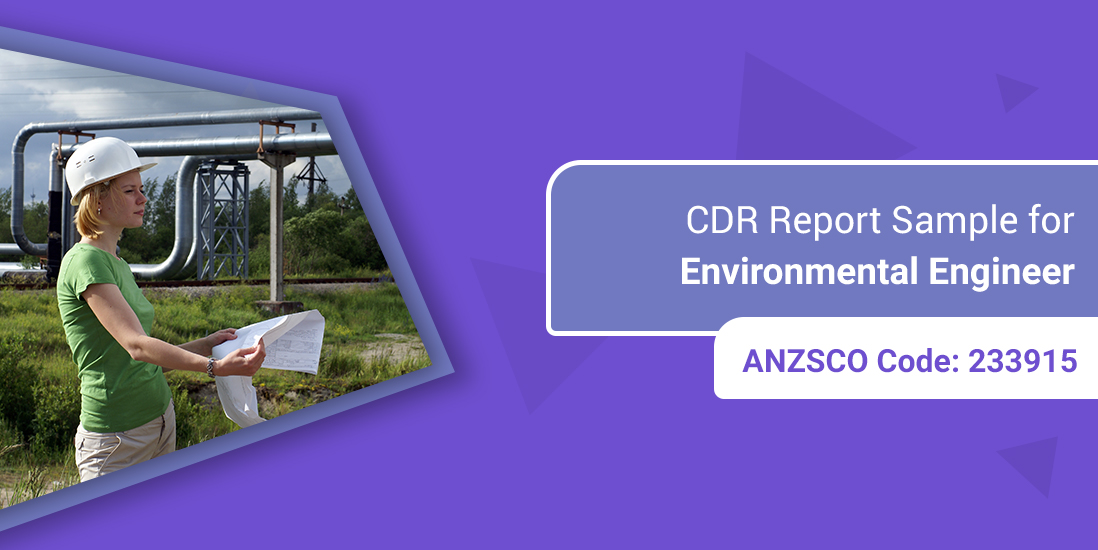CDR Sample for Environmental Engineer

You can get 100% genuine CDR Sample for Environmental Engineer written by our professional and skilled engineering writers. The samples we provide are the report which have already been submitted and positively assessed by the Engineers Australia for Skilled Migration Visa. Please use the sample for reference purpose only and do not copy and paste from the sample.
CDR Report Sample: Environmental Engineer ANZSCO Code: 233915
CDR Sample for Environmental Engineer includes all the necessary reports such as Three Career Episodes, Continuing Professional Development, Summary Statement and Curriculum Vitae. The Content of the CDR Report Sample is as follows:
- Curriculum Vitae: Resume based on a professional template.
- Continuing Professional Development Sample: CPD Sample clearly explains the author’s Engineering Knowledge- 1000 words.
- Environmental Engineer Career Episode Report Sample – 1: “Hydraulic Conductivity, Infiltration, and Runoff from No-till and Tilled Cropland”- 1850 words.
- Environmental Engineer Career Episode Report Sample – 2: “Finding Robust Solutions against Environmental Changes”- 1700 words.
- Environmental Engineer Career Episode Report Sample – 3: “Environmentally Friendly Pultrusion”- 2100 words.
- Environmental Engineer Summary Statement Sample: Detail explanation of all the competency element- 1500 words.
Environmental Engineer Career Episode Report: Sample 1
Project Name: Hydraulic Conductivity, Infiltration, and Runoff from No-till and Tilled Cropland
In first career episode, the author describes the project he did for the partial fulfillment of requirements for the Degree of Master of Science. The project’s name was “Hydraulic Conductivity, Infiltration, and Runoff from No-till and Tilled Cropland”. The responsibilities of the author were:
- To quantify the satiated hydraulic conductivity and runoff on center pivot irrigated, long-term no-till systems
- To determine the effect of slot, ridge, and disk planting on the satiated hydraulic conductivity in a furrow irrigated field and measure satiated hydraulic conductivity on dryland tilled and no-till plots
- To investigate factors that may increase the satiated hydraulic conductivity and decrease runoff
- To study center pivot irrigated tilled and no-till fields to determine the effect of no-till planting on infiltration and runoff
- To investigate four pedotransfer functions models: Crust Factor, ROSETTA, an equation used in the Water Erosion Prediction Project (WEPP) and Soil Water Characteristics tool (SWC) to determine which equation most accurately describes satiated hydraulic conductivity when both tilled and no-till fields are considered.
Environmental Engineer Career Episode Report: Sample 2
Project Name: Finding Robust Solutions Against Environmental Changes
In second Career Episode, the author prepared this thesis for the degree of Doctor of Philosophy. His duties and responsibilities in the project “Finding Robust Solutions Against Environmental Changes” were:
- To describe ROOT problems and solutions to ROOT
- To provide two benchmarks developed for ROOT
- To propose a novel algorithm framework specially for solving ROOT
- To demonstrate the advantage of the proposed framework by comparing a few representative TMO approaches with an instantiation of the proposed framework
- To use dynamic handling strategy
Environmental Engineer Career Episode Report: Sample 3
Project Name: Environmentally Friendly Pultrusion
In third Career Episode, the author demonstrates her technical skills sh used to complete the project she presented as his Bachelor’s degree. The project was “Environmentally Friendly Pultrusion”. The key responsibility of the writer was:
- To develop an environmentally-friendly pultrusion technique for the production of the fibre-reinforced composites
- To analyse the physical, mechanical and thermo-mechanical properties of the composites pultruded
- To design and evaluate a rig for the lateral spreading of the rovings
- To design and evaluate resin impregnators to develop the clean pultrusion technique
- To demonstrate the clean pultrusion technology in the laboratory and under industrial conditions
- To compare the properties of the composites obtained using the clean and conventional pultrusion processes
- To undertake an LCA on the clean and conventional pultrusion processes
- To find a new solution for a mechanically based water treatment plan
- To determine most efficient operating parameters (centrifugation-number and centrifugation–duration) during centrifugation
- To separate the solid components as well as reduce the bacteria by low-pressure ultrafiltration
- To determine which method was most suitable for the separation of the algae and solids in the water of the seal basin with an allowable maximum solids content of 15 mg/L
- To construct the disc separator
- To determine the cost analysis report

